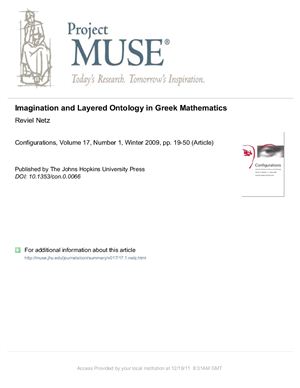Configurations.
Volume 17, Numbers 1-2, Winter 2009.
pp. 19-50.
Subject Headings:
Mathematics, Greek - Philosophy.
Imagination (Philosophy).
Abstract:
This essay is a study in the routine use of imagination in Greek mathematical writings. By "routine" is meant both that this use is indeed very common, and that it is ultimately mundane. No flights of fancy, no poetical-like imaginative licenses are at stake. The issue rather is the systematic use made of the ability to imagine a virtual presence, and to refer to this virtual presence as if it were on equal footing with the real. This process is not merely routine in Greek mathematics: it may well be considered one of its chief characteristics. In this essay, I describe some features of this practice in detail, and then briefly offer some interpretative comments on the history and philosophy of this practice. The emphasis, however, is on the description, and I concentrate mainly on one key element—the use of the Greek verb noein. Thus the structure of the essay is as follows: part 1 is an analysis of noein in Greek mathematical writings; part 2 is a less-detailed description of other practices of Greek mathematics that involve "imagination" or, in general, a "layered" reality; and part 3 is a tentative interpretation.
Volume 17, Numbers 1-2, Winter 2009.
pp. 19-50.
Subject Headings:
Mathematics, Greek - Philosophy.
Imagination (Philosophy).
Abstract:
This essay is a study in the routine use of imagination in Greek mathematical writings. By "routine" is meant both that this use is indeed very common, and that it is ultimately mundane. No flights of fancy, no poetical-like imaginative licenses are at stake. The issue rather is the systematic use made of the ability to imagine a virtual presence, and to refer to this virtual presence as if it were on equal footing with the real. This process is not merely routine in Greek mathematics: it may well be considered one of its chief characteristics. In this essay, I describe some features of this practice in detail, and then briefly offer some interpretative comments on the history and philosophy of this practice. The emphasis, however, is on the description, and I concentrate mainly on one key element—the use of the Greek verb noein. Thus the structure of the essay is as follows: part 1 is an analysis of noein in Greek mathematical writings; part 2 is a less-detailed description of other practices of Greek mathematics that involve "imagination" or, in general, a "layered" reality; and part 3 is a tentative interpretation.

